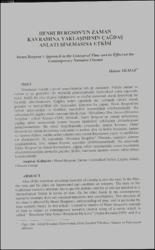| dc.contributor.author | Yılmaz, Hakan | |
| dc.date | 2015-04-16 | |
| dc.date.accessioned | 2015-04-16T08:52:39Z | |
| dc.date.available | 2015-04-16T08:52:39Z | |
| dc.date.issued | 2011 | |
| dc.identifier.issn | 1302-1265 | |
| dc.identifier.uri | http://hdl.handle.net/11630/3861 | |
| dc.description.abstract | Sinemanın önemli yapısal unsurlarından biri de zamandır. Filmde
zaman ve mekan iç içe geçmekte, bir bütünlük göstermektedir. Geleneksel
anlatı yapısında öykü, belirli bir olay örgüsü bulunmakta ve olaylar zamansal
olarak kronolojik bir biçimde aktarılmaktadır. Çağdaş anlatı yapısında ise,
zamanda sürekli olarak geçişler ve belirsizlikler söz konusudur. Zamanın bu
yapısı, Henri Bergson’un zaman anlayışından ve özellikle süre-bellek
kuramından etkilenmektedir. Bu çalışmada bir çağdaş anlatı sineması örneği
olan “Hiroshima Mon Amour-Hiroşima Sevgilim” (Alain Resnais-1959)
filminde, Henri Bergson’un zaman anlayışının, çağdaş anlatı sinemasının
zaman boyutu üzerindeki etkilerinin çözümlenmesi amaçlanmaktadır. Bu
amaç doğrultusunda çalışmada, zaman kavramı, Henri Bergson’un zaman
kavramına yaklaşımı ve analizi, süre ve bellek kuramları, zaman ve sinema
ilişkisi, çağdaş anlatı sinemasında zaman boyutunun yapısı ve özellikleri ele
alınmaktadır. Bu kapsamda “Hiroşima Sevgilim” filminde, yapısalcı yöntem
uygulanmakta, film, zaman boyutu açısından çözümlenmektedir. Bu
çerçevede Henri Bergson’un zaman kavramının, çağdaş anlatı sinemasında
zaman boyutunun oluşturulmasındaki-zamanda geçişler, bellek, hatırlama,
unutma, anılar- etkisi ortaya konulmaktadır. | en_US |
| dc.description.abstract | One of the important structural elements of cinema is also the time.
In the film, the time and the place are intertwined and constitute an integrity.
The story in the traditional narrative structure has a specific plotline and the
events are narrated in a chronological format in terms of time. On the other
hand, in the contemporary narrative structure there are constant transitions
and uncertainties. This structure of the time is affected by Henri Bergson’s understanding of time, and in particular by time-memory theory. In this
article is aimed to resolve of Henri Bergson's concept of time to impact on
contemporary narrative cinema using of a movie which is called “ Hiroshima
Mon Amor-Hiroshima My Love” (Alain Resnain-1959) and it is an example
of a contemporary narrative cinema. In order to reach this goal, the concept
of time, Henri Bergson's approach to the time concept and its analysis,
theories of time and memory, time and cinema relationship, the structure of
the time dimension and its properties in the modern narrative cinema are
discussed in this study. In this context, in the "Hiroshima Beloveds" film, the
structuralist method has been applied and the film has been resolved in terms
of time dimension. Within this framework, the effects of Henri Bergson’s
time concept -transitions in time, memory, recollection, oblivion, and
memoirs- in the formation of time dimension in the contemporary narrative
cinema are put forward. | en_US |
| dc.language.iso | tur | en_US |
| dc.publisher | Afyon Kocatepe Üniversitesi | en_US |
| dc.rights | info:eu-repo/semantics/openAccess | en_US |
| dc.subject | Henri Bergson | en_US |
| dc.subject | Zaman | en_US |
| dc.subject | Geleneksel Anlatı | en_US |
| dc.subject | Çağdaş Anlatı | en_US |
| dc.subject | Filmsel Zaman | en_US |
| dc.title | Henri Bergson’un Zaman Kavramına Yaklaşımının Çağdaş Anlatı Sinemasına Etkisi | en_US |
| dc.title.alternative | Henri Bergson’s Approach to the Concept of Time and Its Effect on the Contemporary Narrative Cinema | en_US |
| dc.type | article | en_US |
| dc.relation.journal | Sosyal Bilimler Dergisi | en_US |
| dc.department | Afyon Kocatepe Üniversitesi, Güzel Sanatlar Fakültesi, Sinema ve Televizyon Bölümü | en_US |
| dc.identifier.volume | 13 | en_US |
| dc.identifier.startpage | 61 | en_US |
| dc.identifier.endpage | 78 | en_US |
| dc.identifier.issue | 2 | en_US |
| dc.relation.publicationcategory | Makale - Uluslararası Hakemli Dergi - Kurum Yayını | en_US |



















